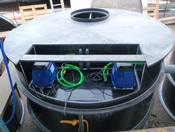Linear Pumps

A linear diaphragm pump has the unique feature that the drive / motor itself has no wearing parts. Linear diaphragm pumps work on the principle of a magnetic shuttle held by the diaphragms of opposed heads. On either side of the shuttle is an electromagnetic which is enegised by an alternating voltage oscillating at 50 or 60 Hz. The magnetic shuttle moves linearly between the poles of the electromagnet attempting to close the magnetic field at the same frequency of the applied voltage. This motion is used to move the diaphragm inside the linear diaphragm pump. With no wearing drive parts the life of the pump is determined by life of the diaphragm. A second feature of linear pumps is that the stroke is not constant. It is greatest at open flow and reduces with increasing pressure or vacuum. Compared to a constant stroke pump, for example a DC motor driven diaphragm pump, the flow curve is steeper since the compression ratio decreases with increasing pressure. Typical maximum differential pressures of a linear diaphragm pump is ± 500 mbar. Low working pressures and a zero-wear drive combine to provide a linear diaphragm pump with its greatest advantage: extremely long life. The larger pumps will typically run over 20,000 hours, whilst the small models will run well above this level. Service kits are available which comprise of new diaphragm, head and valves. Essentially once a service is complete, the linear diaphragm pump, from a life perspective, is new.
…. the Parameters for Aeration
A very popular application for a linear diaphragm pump is the aeration of water. Typically pressures are low and run times are long, if not continuous. The features of linear diaphragm pumps can therefore be fully utilised. This can be for aquatics and pond aeration but also for sewage aeration in decentralised sewage treatment. In Europe approximately 90% of households are connected to municipal sewage systems. The remaining, typically in rural locations rely on a decentralized sewage treatment and sewage aeration systems. This can be one sewage treatment system per household or one per cluster of households. European law dictates the quality of any discharge entering the ground water. Often this can only be achieved with a sewage treatment system. Flow requirement are typically 60 to 120 l/min at 150 to 200 mbar. Linear diaphragm pumps are at the heart of a sewage aeration system and provide not only the air for aeration but also for air lifters to move liquids from chamber to chamber within the sewage treatment system. With ever increasing energy costs it is also important for the end user of sewage aeration and pond aeration systems that the linear diaphragm pump runs efficiently. The higher efficiency linear diaphragm pumps run at 0.6 to 0.7 watts per litre of air. Since a sewage aeration pump can run between 30 % and 100% of the time, energy consumption is significant contributor to the overall costs.
Beyond sewage aeration for decentralised sewage treatment and pond aeration the small linear diaphragm pumps are used in medical, environmental and other industrial applications. For medical they can be found in air mattress, compression therapy and massage systems. For environmental systems a linear diaphragm pump is an excellent choice for continuous air and gas monitoring due to life exceeding many years of operation. Industrial applications include fuel cell systems requiring high efficiency or indeed linear diaphragm pumps can be found as vacuum or pressure generators, or part of cooling and drying systems.
.... the Range
The Airmac range of linear diaphragm pumps from Diann Bao cover a range from small OEM pumps starting at 5 l/min, through the mid-range pumps of 60 to 120 l/m complete with robust housing and power cord, typically for sewage treatment in of decentralised sewage systems and pond aeration. Models include the DT60, DBMX80 and DBMX120. The models extend to 400 l/min for the needs higher flow sewage aeration systems, for example for rural hotels or clusters of households.
